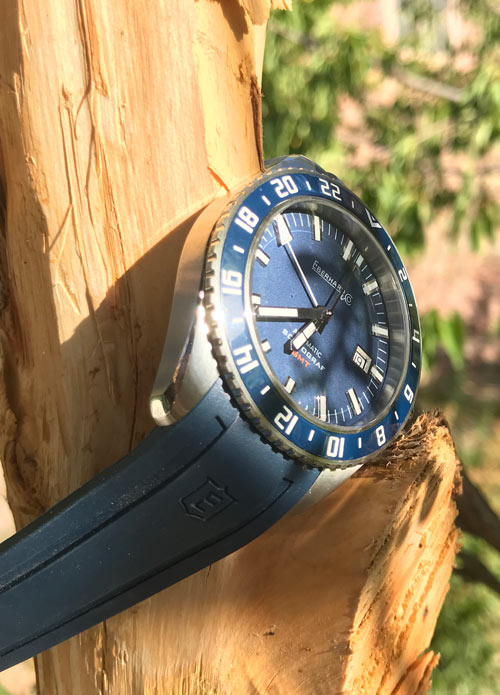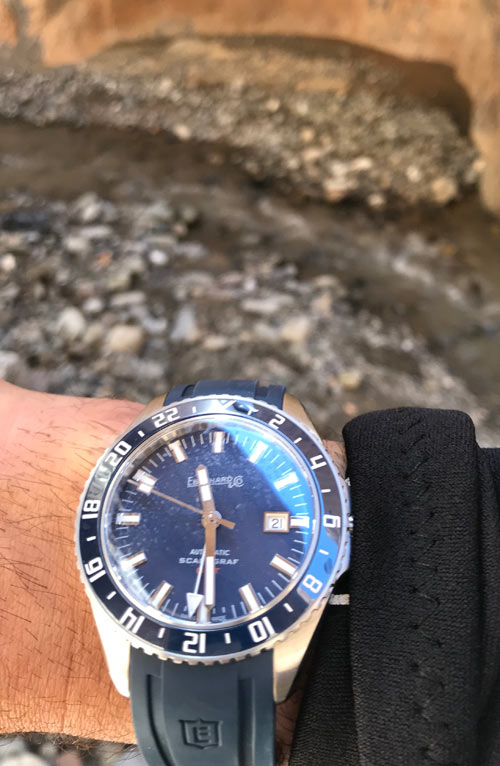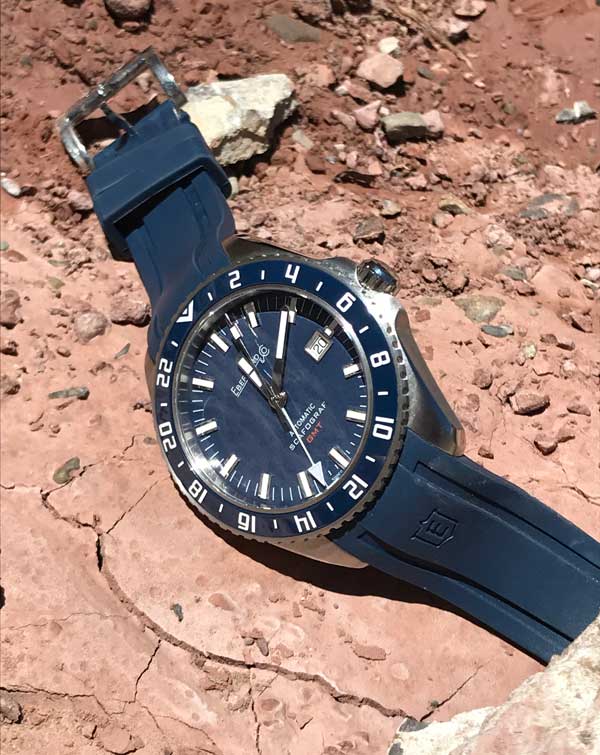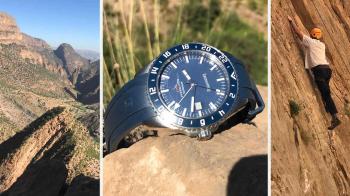What watch brands tell you is one thing, but the reality is often quite different. Here at WorldTempus, we’re fans of reality. Our mission was to evaluate these rugged claims. After several expeditions to the far north (with Alpina, Zenith and Ball Watch) we set out once again, this time to Africa and Morocco’s High Atlas mountains. Eberhard & Co. was game for an evaluation under real-life conditions.

A tactical choice: the Scafograf GMT
Our choice of watch was determined by several criteria. First and foremost was robustness. The Scafograf GMT by Eberhard & Co. is made of steel, with a rubber strap, screwed back and crown, sapphire glass and ceramic bezel; in other words, it’s solid.
Then comes the complication. The Scafograf GMT comes with a second time zone. For a real-life test in deep water this is a must for anyone who doesn’t have their own private diving pit! In all other cases, you’ll be travelling to more or less distant shores, which makes a second time zone a priority.
And finally: cost. There are plenty of “all-terrain” watches out there, but not everyone has the means to drop CHF 40,000 on one for the summer holidays. The Scafograf GMT was also chosen for its unbeatable price tag: CHF 3150.
More subjectively, the Scafograf GMT has a youthful, sporty appearance that is very appealing. It’s modern, dynamic, easy to read and perfectly finished, with an engraving on the caseback that adds to its character. Ideal for the summer!

And we’re off
The first testing criterion was comfort. An all-terrain watch should be functional but unobtrusive. With its diameter of 43 mm, the Scafograf GMT ticks this box. Its dark blue dial increases contrast, thus enhancing legibility. The bezel requires some force to turn, and that’s a good thing, because there is very little risk of moving it accidentally.
The steel case is a weighty presence on the wrist. It’s a gauge of the watch’s sturdiness, but titanium would be considerably lighter. However, while in an ideal world, titanium would have been preferable, it would also have considerably raised the price. So steel, with its proven track record and more competitive pricing, is a perfectly logical choice.
Nevertheless, Eberhard & Co. could have chosen to supply the watch with a titanium pin buckle. It’s the smallest component of the watch, and thus the cheapest to produce, but it’s also the part that is the most vulnerable to scratches. A titanium buckle would not have significantly inflated the price, but it would have guaranteed that this hardworking part of the watch retained its original lustre. Something to think about, perhaps, the next time the range is due for an update?
Finally, the watch has a two-day power reserve, which is a point in its favour even though, for an automatic movement subject to daily activity, this is largely irrelevant.

Testing times
Trekking, canyoning, mountain biking, hiking, camping, climbing... over the course of the week, the Scafograf GMT endured practically everything that I could throw at it. Trekking provided an opportunity to check how comfortable the watch was in wear, particularly the rubber strap, which can sometimes be uncomfortable in high heat and/or over long periods of exertion (sweat, discomfort, irritation).
The strap of the Scafograf GMT performed adequately, with a few reservations. First, there is the micro-engraving of the Eberhard & Co. logo over the entire back of the strap. It’s an original aesthetic touch, but it does somewhat detract from the comfort. Then there is the rubber’s reaction to friction. It appears to pick up white wear marks quite quickly. But it’s not a deal-breaker, and may be unavoidable with this material.
But the overall robustness of the case was certainly a plus. Climbing and canyoning, with their inevitable contact with rock faces, left not a single trace on the case. The sapphire glass still looked like new after an intense week. The ceramic bezel likewise – not a scratch. The crown protectors are both discreet and perfectly designed, given that the crown also emerged completely unscathed. The watch itself certainly delivers in terms of aesthetic longevity.
As far as water resistance is concerned, the longstanding pedigree of the Scafograf line is also a point in this GMT model’s favour. We even subjected the watch to the ordeal of canyoning... with the crown half unscrewed! This is definitely not recommended, as well as being dangerous, and patently unfair... but accidents do happen. At the end of half a day of immersion, the Scafograf GMT remained perfectly water tight, despite this degrading treatment. This is a real bonus for the klutzes among us!

A solid pass
After an arduous week, the Scafograf GMT scored top marks. Precision, robustness, reliability, aesthetic appeal, price: it ticks all the boxes. The La Chaux-de-Fonds watchmaker remains true to its principles, producing watches that are well designed, fit for purpose and fairly priced. This Scafograf GMT is a convincing modern interpretation, while period pieces (dating from 1959) are starting to attract attention at auction. You should definitely take a look, before you head off for the beach.






